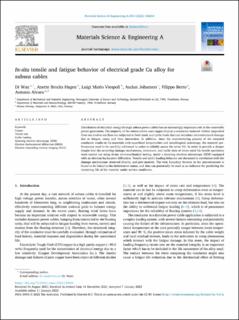| dc.contributor.author | Wan, Di | |
| dc.contributor.author | Hagen, Anette Brocks | |
| dc.contributor.author | Viespoli, Luigi Mario | |
| dc.contributor.author | Johanson, Audun | |
| dc.contributor.author | Berto, Filippo | |
| dc.contributor.author | Alvaro, Antonio | |
| dc.date.accessioned | 2022-06-07T10:16:13Z | |
| dc.date.available | 2022-06-07T10:16:13Z | |
| dc.date.created | 2022-01-14T15:14:37Z | |
| dc.date.issued | 2022 | |
| dc.identifier.citation | Materials Science and Engineering: A, 2022, 835, 142654, 1-10 | en_US |
| dc.identifier.issn | 0921-5093 | |
| dc.identifier.uri | https://hdl.handle.net/11250/2997656 | |
| dc.description.abstract | Distribution of electrical energy through subsea power cables has an increasingly important role in the renewable power generation. The majority of the subsea cables uses copper (Cu) as a conductor material. Cables suspended from sea level to sea floor are subjected to both static and cyclic loads that can introduce microstructural damage due to fatigue, creep and their interaction. In addition, since the manufacturing process of the stranded conductor results in Cu-materials with superficial irregularities and metallurgical anisotropy, the material performances need to be carefully addressed in order to reliably assess the wires life. In order to provide a deeper insight into the occurring damage mechanisms, monotonic and cyclic tests of micro-sized Cu tensile specimens were carried out using in-situ micromechanical testing, inside a scanning electron microscopy (SEM) equipped with an electron backscatter diffraction. Tensile and cyclic loading behavior are discussed in correlation with the damage mechanisms observed directly and post-mortem. The twin boundary fraction in the microstructure is found to be linked to the deformation status, and thus can potentially be used as an indicator for predicting the remaining life of the material under service conditions. | en_US |
| dc.language.iso | eng | en_US |
| dc.publisher | Elsevier | en_US |
| dc.rights | Navngivelse 4.0 Internasjonal | * |
| dc.rights.uri | http://creativecommons.org/licenses/by/4.0/deed.no | * |
| dc.subject | Electron channeling contrast imaging (ECCI) | en_US |
| dc.subject | Electron backscattered diffraction (EBSD) | en_US |
| dc.subject | Scanning electron microscopy (SEM) | en_US |
| dc.subject | Cyclic loading | en_US |
| dc.subject | Tensile test | en_US |
| dc.subject | Copper | en_US |
| dc.title | In-situ tensile and fatigue behavior of electrical grade Cu alloy for subsea cables | en_US |
| dc.type | Peer reviewed | en_US |
| dc.type | Journal article | en_US |
| dc.description.version | publishedVersion | en_US |
| dc.rights.holder | © 2022 The Author(s). Published by Elsevier B.V | en_US |
| dc.source.pagenumber | 10 | en_US |
| dc.source.volume | 835 | en_US |
| dc.source.journal | Materials Science & Engineering: A | en_US |
| dc.identifier.doi | 10.1016/j.msea.2022.142654 | |
| dc.identifier.cristin | 1981424 | |
| dc.source.articlenumber | 142654 | en_US |
| cristin.ispublished | true | |
| cristin.fulltext | original | |
| cristin.qualitycode | 2 | |

